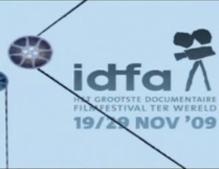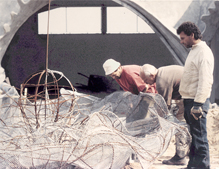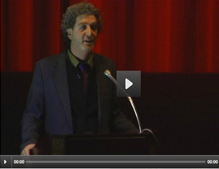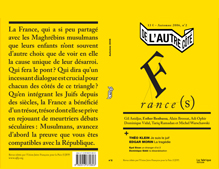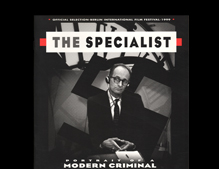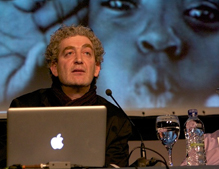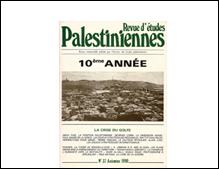-
Proposal for a visual media exhibition
with the participation of students of the Master of Film at the Dutch Film Academy, Amsterdam -
Get my films
Buy DVDs online at www.momento-films.com -
IZKOR
slaves of memory
Documentary film | 1990 | 97 min | color | 16mm | 4:3 | OV Hebrew ST -
Common Archive Palestine 1948
web based cross-reference archive and production platform
www.commonarchives.net/1948 - Project in progress - -
Montage Interdit [forbidden editing]
With professors Ella (Habiba) Shohat and Robert Stam / Berlin Documentary Forum 2 / Haus der Kulturen der Welt / June 2012 -
Route 181
fragments of a journay in Palestine-Israel
Documentary film co-directed with Michel Khleifi | 2003 | 272 min [4.5H] | color | video | 16:9 | OV Arabic, Hebrew ST
-
The Specialist
portrait of a modern criminal
Documentary film | 1999 | co-author Rony Brauman | 128 min | B/W | 4:3 | 35 mm | OV German, Hebrew ST -
Jaffa
the orange's clockwork
Documentary film | 2009 | 88 min | color & B/W | 16:9 | Digital video | OV Arabic, Hebrew, English, French ST
-
Montage Interdit
www.montageinterdit.net
Web-based documentary practice. A production tool, archive and distribution device | project in progress
-
Common State
potential conversation [1]
Documentary film | 2012 | 123 min | color | video | 16:9 split screen | OV Arabic, Hebrew ST -
Towards a common archive
testimonies by Zionist veterans of 1948 war in Palestine
Visual Media exhibition | Zochrot Gallery (Zochrot visual media lab) | Tel-Aviv | October 2012 - January 2013
-
I Love You All
Aus Liebe Zum Volk
Documentary film co-directed with Audrey Maurion | 2004 | 89 minutes | b/w & color | 35mm | OV German, French ST
JERUSALEM(S), Borderline Syndrome 1994
65 minutes | 16 mm | Colour | 4:3 | Stereo | 1994 / OV : Hebrew & Arabic




This iconoclastic film, midway between fiction and documentary, explores the "over-sacred" side of Jerusalem. A political gamble for its inhabitants, a myth for its visitors, Jerusalem remains a universal object of desire that borders on fetishism. The film takes its inspiration from the Jerusalem Syndrome, a psychiatric syndrome, officially recognised in the 19th century, and from which the pilgrims and tourists that visited the Holy City suffered. A camera visits Jerusalem looking for a new approach to show the city. In parallel a young boy wanders the streets and discovers one night a prostitute with golden breasts. The boy, as does the camera, becomes a victim of a violently feminine Jerusalem.
ABOUT THE FILM
At the beginning of this century, a particular form of hysteria was discovered, known as “Jerusalem Fever”, which affected pilgrims visiting the Holy City. This syndrome is perhaps one of the city’s underlying truths.
Jerusalem(s) Borderline Syndrome, analyses the often irrational relationship that men and women sometimes have with an object, an image or a symbol. Late at night, a child wanders through the streets of Jerusalem in search of the woman with golden breasts that once glimpsed.
In parallel, the camera, a character in its own right, investigates the daily reality of this divided city. It runs into invisible borders and, from fear of filming things that have already been filmed a thousand times, tries, without really succeeding, to escape the Jerusalem syndrome.
The Jerusalem Syndrome: a psychiatric syndrome, officially recognised in the 19th century, and from which the pilgrims and tourists that visited the Holy City suffered.
This iconoclastic film, midway betwen fiction and documentary, explores the "over-sacred" side of Jerusalem. A political gamble for its inhabitants, a myth for its visitors, Jerusalem remains the universal object of desire that borders on fetichism.
A camera visits Jerusalem looking for a new approach and in paralell a young boy wanders the streets and discovers one night a prostitute with golden breasts.
The boy, as does the camera, become victims of a violently feminine Jerusalem...
Some notes about the film... based on a text by Dan Dulberger
Every war imbues certain objects, signs or places with an importance not necessarily proportional to their primary strategic value. Having thus been imbued, such fetishes then serve as irrational reservoirs of attraction, obsession, and the inevitable clash between generations of conflicting parties.
Jerusalem is (since it has always been part of people’s fantasy) the fetish of the conflict between the European and Middle Eastern cultures. As the tension between the Muslim and the (now Judeo)-Christian worlds re-surfaces, the Jerusalem fetish is expected to reaffirm its archetypal influence on the antagonists’ sense of identity, purpose and mutual difference.
The Jerusalem fetish consists of a dome, a wall and a sepulchre. Within these competing architectures is embodied the perpetuation of their self-differentiation through the infantile fantasy of possessing something all to oneself. Jerusalem itself has faded into insignificance behind the icons of a much disputed prize.
In this context, a documentary film about Jerusalem is, by definition, impossible. Aiming for an “authentic” image, in an existentialist sense, of whatever Jerusalem(s) “there” may be “out there”, the film finds itself confronted with manufactured images. All that remains to be done, is to render a picture of a picture. Not being able to penetrate the thick gloss of the image, we lose sight of the distinction between image and reality. One’s vision is constrained by the pre-existing image.
Since it is confronted from the start with a fetishist image, not with a reality to be imagined, all the camera can do is de-compose and de-fetishise it. All the freedom it has in such a situation derives from the act of taking the image apart, de-processing it back into the chaotic, primeval, fleeting stimulus.
It is a liberation of reality from the tyranny of the politicised image.
Jerusalem(s), Borderline Syndrome represents this effort.
The Jerusalem archetype is feminine, maternal - the dome is a breast. There is a constant rape of the symbol. The myriad offspring of Jerusalem the whore, come to convince her with their flattery that she should recognise each of them as her only son. But no-one is the only son. She has many. The living are of no importance to her. Jerusalem is a necrocracy. A city of the dead. The place of legitimate irrational resurrection for both religions.
The dual image - east-west - has actually taken over its referent. It is impossible today to form an impression of the city independently from this dual image. The image totally controls the field of vision of this city. It camouflages the city itself. Scratch the golden painted surface and you will discover its invisibility.
"JERUSALEM(S)” by Eyal Sivan
"A totally new atmosphere currently reigns over Jerusalem. For the first time in its bloody history, the City will perhaps soon live up to its mythical, and previously fictitious, name of “Jerusalem, City of Peace”. The politics surrounding the City may be no longer impede our vision. Today, just as everything suggests that the City will at last regain a peaceful existence, I want her to explain the mysterious adoration she enjoys.
More than a physical entity, Jerusalem is often perceived as a concept. Any talk about the city, any observation about the place becomes a way of appropriating it. But the city, like a teasingly seductive woman, shies away from those who would possess her. A visitor passing through may leave with a sense of satisfaction, perhaps due to the illusion of having fulfilled a fantasy. But the city’s inhabitants, who do not perceive it as a vast site of worship, are consciously frustrated. In the shadow of the myth, in the largest living museum of all time, it is very difficult for them to maintain their human dimension. Passionate, they sometimes prefer self-exile rather than to suffer this one-way love affair.
This is why I left Jerusalem, ten years ago.
Today, I return to the city of my childhood, my youth. The city that I left at the first opportunity. Scenery that I left without looking back. Places that I left without remorse. Abandoned memories. Forgotten friends.
This is the fulfilment of a fantasy, an act made possible only through film.
Jerusalem can tell her own story about the irrational love that mankind has for her, through archive footage, and present day film. Jerusalem is like a woman lying on a psychiatrist’s couch.
Seized with fear of filming over-cliched images, the camera tries hard, right up to the last scene, to fight the destiny that draws it irresistibly towards the couch.
Showing one’s home city, when it is a city like Jerusalem, not that there can be another like it, is to show an object of adoration and worship. Neither a tourist film, nor an historical presentation, nor a political investigation, rather a film made with the City as its starting point. The memory of how I saw the City as a child living there, a view neither too close, nor too distant, neither too hot nor too cold, not cynical, a film with a light sense of humour. The current research of an adult against the grain.
From East to West, she is observed. The whole world is in her possession. Her photo, as that of a lost wife or mother, hangs on walls, all over the world.
She had three lovers. The first took his son to slaughter; she kept her silence, in complicity. The second was tortured, crucified, she was stained by his blood; she remained imperturbable. The third left her on a white horse, he rose to heaven; and then her breasts were painted gold.
Three sons, of an unknown, unseen and indescribable yet ever present father, identified her as their mother.
“How did you become a whore, you the city of faith, home to thieves and murderers?” lamented the prophet Isaiah. King Solomon, who wrote The Song of Songs, admired her good looks. She has been in constant transformation, calm and golden, proud and solitary, seventeen times raped, twenty times ravaged, then rebuilt, dressed anew, ever more imposing, more beautiful, more courted. “Let us conquer her”, vaunted the Crusaders, “It is on her, in possessing her, that we shall find our deliverance.”
I saw it.
One day, at the corner of a narrow alley, through a barred window, in a vaulted room, a body was sprawled on the bed, the abused body hidden under layers of once sumptuous make-up, a large lady with golden breasts.
To think of yet another film about this place, about this geographic area, about this landscape, about this city, that perhaps exists only on postcards. To think that it is possible to add another image of this, the city of all clichés. An awesome project.
Jerusalem, city of historical symbols, city of the mad, city of the kitsch, necropolis of all passions. I return to Jerusalem to find my way, to find the view which, I hope, will take me to this woman, to shatter an illusion of my childhood.
Or perhaps not.”
Eyal Sivan, Paris, 1994
© La Sept ARTE [FR] l momento! l AMYTHOS [FR]
JERUSALEM(S), BORDERLINE SYNDROME
65 minutes | 16 mm | Colour | 4:3 | Stereo | 1994
OV : Hebrew & Arabic
Sub-titles : French, English, Spanish
A FILM WRITTEN AND DIRECTED BY
Eyal SIVAN
WITH
Dan DULBERGER
Amalia SAND
AND
Izak KONFINO
Shay LAUFER
IMAGE
Nurith AVIV
SOUND
Rémy ATTAL
EDITOR
Sylvie PONTOIZEAU
PRODUCTION MANAGER
Karin SIVAN
EXECUTIVE PRODUCER
Eyal SIVAN
ASSISTED BY
Armelle LABORIE
CAMERA ASSISTANT
Sophie CADET
GAFFER
Avi AVNAEEM
ASSISTED BY
Yuval GALRON
GRIP
Noam IZENBERG
ASSISTED BY
Ronen NEAMAN
2nd SOUND
Amir BUVERMAN
ART DIRECTOR
Judie LOMS
ASSISTED BY
Tom AZEN
MAKE UP
Déborah SHILO
SET PRODUCTION
Anat ASSULIN
Avi GALANTY
COORDINATION
Dany (Nokio) VERETÉ
Georges KHLEIFI
EDITING ASSISTANTS
Sylvie ADNIN
Jeanne MOUTARD
TRAINY
Maya CYPEL
ASSOCIATE PRODUCER
Amit BREUER
PRODUCTION CONSULTANT
Michel KHLEIFI
PRODUCTION ASSISTANT
Alice BOUCHER
AKNOWLEDGMENTS
Anwar ABU EISHEH - Dr Pierrette ANTONA - Luc BÉRANGER - Ruth BNIEL - Tomas ORLOWSKI - Elias SANBAR - Billy SEGAL - Philippe VERRIÈRE - Centre de Santé Mentale KFAR SHAUL - Salles Mondial Renaissance - Haute Autorité pour les Antiquités.
TEXTS
THE BIBLE
« AL-QUDS » by FAYROUZ
POEM BY Moudafar AL-NAWAB
ARCHIVES
IBA Israeli Television
AL-QUDS Television Production
OLP Culture Department
WITH THE PARTICIPATION OF
CENTRE NATIONAL DE LA CINÉMATOGRAPHIE
STOCK
KODAK
BASF
LABORATOTY
RANK FILM LABORATORIES
RENT MATERIAL
PRAXIMAGE
ON AIR
POST-PRODUCTION
SON POUR SON
«
A violence and a tension indicate us our presence in Jerusalem.
Nouvel Observateur
An ironical metaphore about a town overcome with a mad destiny.
Le Monde
The harshness of Eyal Sivan' eyes will give the shivers to more than one. His portrait of love and hatred, between attraction and repulsion, is worth a watch, if only because he takes the liberty of raising against the spiritually correct cliché of "holy city".
Tribune Juive
»
05/21/1995 - "Jérusalem(s)" by Catherine Humblot (Le Monde)
05/18/1995 - "Jérusalem : un bien curieux hommage…" by Lise Benkemoun (Actualité Juive)
05/18/1995 - "Jérusalem, une pierre dans les cœurs" (La Vie)
05/18/1995 - "Quel avenir pour Jérusalem ?" by Franck Gatti (L'Humanité Dimanche)
05/18/1995 - "Le syndrome de Jérusalem" by Véronique Blamont (TéléObs)
05/18/1995 - "Jérusalem now" by Jacques Mandelbaum (Tribune Juive)
05/17/1995 - À propos de "Jérusalem, Jérusalems: Regards sur une ville" et de "Jérusalem, le syndrome borderline" by Antoine Perraud (Télérama)



















